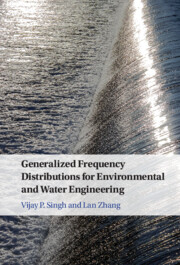Book contents
- Generalized Frequency Distributions for Environmental and Water Engineering
- Generalized Frequency Distributions for Environmental and Water Engineering
- Copyright page
- Dedication
- Contents
- Preface
- Acknowledgments
- 1 Introduction
- 2 Burr–Singh–Maddala Distribution
- 3 Halphen Type A Distribution
- 4 Halphen Type B Distribution
- 5 Halphen Inverse B Distribution
- 6 Three-Parameter Generalized Gamma Distribution
- 7 Generalized Beta Lomax Distribution
- 8 Feller–Pareto Distribution
- 9 Kappa Distribution
- 10 Four-Parameter Exponential Gamma Distribution
- 11 Summary
- Appendix General Procedure for Goodness-of-Fit Study, Construction of Confidence Interval, and 95% Confidence Bound with Parametric Bootstrap Method
- Index
- References
2 - Burr–Singh–Maddala Distribution
Published online by Cambridge University Press: 13 April 2022
- Generalized Frequency Distributions for Environmental and Water Engineering
- Generalized Frequency Distributions for Environmental and Water Engineering
- Copyright page
- Dedication
- Contents
- Preface
- Acknowledgments
- 1 Introduction
- 2 Burr–Singh–Maddala Distribution
- 3 Halphen Type A Distribution
- 4 Halphen Type B Distribution
- 5 Halphen Inverse B Distribution
- 6 Three-Parameter Generalized Gamma Distribution
- 7 Generalized Beta Lomax Distribution
- 8 Feller–Pareto Distribution
- 9 Kappa Distribution
- 10 Four-Parameter Exponential Gamma Distribution
- 11 Summary
- Appendix General Procedure for Goodness-of-Fit Study, Construction of Confidence Interval, and 95% Confidence Bound with Parametric Bootstrap Method
- Index
- References
Summary
The Burr–Singh–Maddala (BSM) probability distribution is a generalization of the Pareto distribution and the Weibull distribution that are used for frequency analyses of a variety of hydrologic and hydrometeorologic data. This distribution possesses a number of interesting characteristics that are discussed in this chapter. The BSM distribution is derived using the entropy theory, which then is applied to derive the BSM distribution parameters. Real-world data are used to illustrate the application of the distribution.
- Type
- Chapter
- Information
- Publisher: Cambridge University PressPrint publication year: 2022

